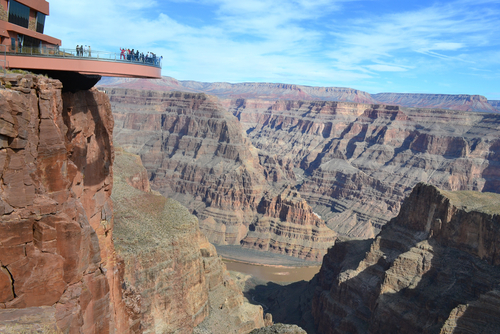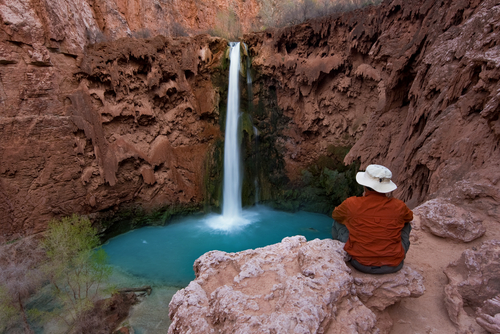Modern Lives and Issues
Today, the Havasupai and Hualapai—who once considered themselves the same people-- are recognized by the federal government as two distinct tribes. The Hualapai tribe now numbers 2300 people, of which about 1300 live on the reservation. After several decades of relying on off-reservation jobs for their income, in the 1960s the Hualapai began to develop recreationally-based programs to attract outdoor enthusiasts and tourists. Today, the tribe operates several tourist-based attractions, including lodges, a river rafting company, and a glass walkway for viewing the Grand Canyon. This Grand Canyon Skywalk, which opened in 2007, extends some 4000 feet above the Colorado River.

Grand Canyon Skywalk on the Havasupai Reservation.
Source - http://www.shutterstock.com/pic-369264470/stock-photo-amazing-view-grand-canyon-skywalk-arizona-usa.html?src=w5f2_geb5GCpjbTjgXHbeg-1-2

Tourist at Mooney Falls, Havasu Canyon.
Source - http://www.shutterstock.com/pic-11000047/stock-photo-young-man-sitting-on-a-cliff-watching-mooney-falls-drop-into-it-s-turquoise-pool-havasu-canyon.html?src=6LooGo5mi-Oi-CzEp4rtNA-2-32
Like the Haualapai, the Havasupai today also rely largely on income from tourism. Some 450 of the 650 tribal members currently live in Supai, their town in the bottom of Cataract Canyon. Supai is extremely remote and even today the only way to get into or out of the canyon is by foot, horse, or helicopter. However, the canyon's lush waterfalls and clear blue waters attract some 12,000 visitors per year, all of whom pay fees to visit. The tribe also operates a campground and hotel in the canyon and offers a mule service to carry passengers and/or their luggage into and out of the canyon.
One of the major issues concerning the Havasupai and Hualapai today is uranium mining. Since the 1950s, uranium mining has been big business on the Colorado Plateau, but because of the harmful legacy of this activity on the Navajo reservation (see Navajo module for more information) most tribes within this region have banned it on their reservation lands.
In the 1990s, the Canadian-based Denison Mines Corporation requested groundwater-aquifer permits from the state of Arizona that would allow them to re-open three mines within and around the Grand Canyon. The Havasupai and Hualapai immediately launched protests, arguing that the opening of these mines threatened their drinking water and traditional religious areas. One of the mines is near Red Butte, a Havasupai sacred site that is where the Havasupai first came into being a separate people. Despite these concerns, in March 2011 Arizona regulators approved the Denison Mines Corporation's request for the groundwater-aquifer permits. Before the mines can re-open the corporation still must obtain federal approval.
One of the major issues concerning the Havasupai and Hualapai today is uranium mining. Since the 1950s, uranium mining has been big business on the Colorado Plateau, but because of the harmful legacy of this activity on the Navajo reservation (see Navajo module for more information) most tribes within this region has banned it on their reservation lands.
In the 1990s, the Canadian-based Denison Mines Corporation requested groundwater-aquifer permits from the state of Arizona that would allow them to re-open three mines within and around the Grand Canyon. The Havasupai and Hualapai immediately launched protests, arguing that the opening of these mines threatened their drinking water and traditional religious areas. One of the mines is near Red Butte, a Havasupai sacred site that is where the Havasupai first came into being a separate people. Despite these concerns, in March 2011 Arizona regulators approved the Denison Mines Corporation's request for the groundwater-aquifer permits. Before the mines can re-open the corporation still must obtain federal approval. The fight against uranium mining thus continues for the tribes.
Click on next page to continue.
